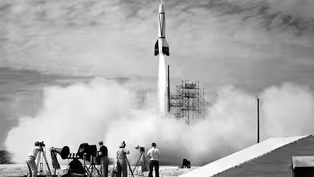
Energy In Space
Clip: Season 2 Episode 1 | 3m 37sVideo has Closed Captions
Astronaut Charles Bolden describes his personal experience of launching into space.
An excerpt from 'Space.' Astronaut Charles Bolden describes his personal experience of launching into space.
Problems playing video? | Closed Captioning Feedback
Problems playing video? | Closed Captioning Feedback

Energy In Space
Clip: Season 2 Episode 1 | 3m 37sVideo has Closed Captions
An excerpt from 'Space.' Astronaut Charles Bolden describes his personal experience of launching into space.
Problems playing video? | Closed Captioning Feedback
How to Watch Power Trip: The Story of Energy
Power Trip: The Story of Energy is available to stream on pbs.org and the free PBS App, available on iPhone, Apple TV, Android TV, Android smartphones, Amazon Fire TV, Amazon Fire Tablet, Roku, Samsung Smart TV, and Vizio.
Buy Now
Providing Support for PBS.org
Learn Moreabout PBS online sponsorship- [Maj. Gen. Charles F. Bolden, Jr.] When I grew up, although I was enthralled by the concept of space flight, there were no astronauts who looked like me.
I lived in the segregated south.
My favorite way to spend my Saturday mornings growing up was to go to the local theater because that was the one day of the week we could go and you sat up in the balcony and we watched two movies.
One was usually "Buck Rogers," and I loved the way he would walk out to his spacecraft, lift off, go to Mars and come back all in the same day.
I was a NASA astronaut, still on active duty in the Marine Corps and I had an opportunity to fly four times on the space shuttle.
My second flight was aboard Discovery, when we deployed the Hubble Space Telescope in 1990.
It takes an extreme amount of energy to get into space.
We are about a 4,000,000 pound vehicle when you talk about the shuttle itself, then the two solid rocket boosters and then the big external tank.
Some people can speak in Newtons, I don't.
We talk about pounds of thrust and so it's about 7,000,000 pounds of thrust to get off the planet.
There's a lot of energy that goes into a lift off.
The three main engines ignite first, it's attached by the two solid rocket boosters, four bolts each and those eight bolts kind of catch it as it falls forward.
We call it the twang and that takes a grand total of seven seconds and in that time, the computers make sure it's okay to go and then they send a signal to the two solid rocket boosters to ignite.
When that happens, it gets exciting.
(intense music) The thing that's not what everybody thinks, everybody thinks you're pressed back in your seat and it's like a lot of G and it's not at all.
It's like being in a car at a stop sign with a teenager who floors the accelerator but you can hear and feel the explosion of the solid rocket boosters and just shakes the vehicle.
The purpose for the solid rocket boosters is to get you up through the atmosphere as quickly as you can and it's essentially a trajectory that's straight up through the atmosphere.
And it continues to vibrate.
After that two minutes, the solid rocket boosters are all spent and fall away.
Then it gets really, really smooth.
The acceleration begins to build up because vehicles now reduced to just the basic shuttle with the external tank, which is almost empty but you're now in a 200 plus thousand pound vehicle with a million and a half pounds of force pushing you along.
Think about the old F equals MA equation.
There's a lot of force, not a lot of mass.
It feels like you have a couple of gorillas sitting on your chest.
As you get toward the eight and a half minute point, you're going 17,500 miles an hour and then your weightless.
(upbeat music) - [Announcer] This is Power Trip, The Story of Energy.
Video has Closed Captions
Preview: S2 Ep1 | 30s | Modern energy takes us on a journey to the final frontier. (30s)
Providing Support for PBS.org
Learn Moreabout PBS online sponsorship
- Science and Nature

Capturing the splendor of the natural world, from the African plains to the Antarctic ice.

- Science and Nature

Explore scientific discoveries on television's most acclaimed science documentary series.












Support for PBS provided by:
